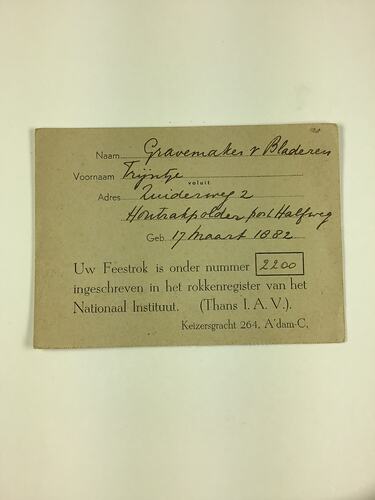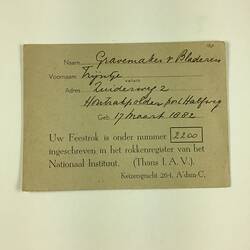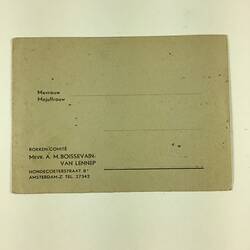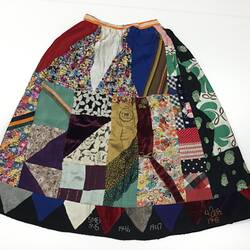Summary
Registration card for a national 'feestrok' skirt dating to the immediate post-WWII period, 1945-48. The registration stamp on the skirt records the year of registration as 1948, and the registration card records in handwritten script the maker's name, address, birthdate of the maker and the number assigned to the skirt.
This Dutch celebration or liberation skirt was made by Trijnje Gravemaker-Van Bladeren (born Sloten 1882; died Haarlem 1955) on her farm in Halfweg, The Netherlands circa 1945-48. It is an adult size skirt but was worn by Trinjnje's eldest granddaughter Tine Roelie Beatrix Gravemaker (born in the Netherlands in 1936; died Melbourne 2024), likely to the annual victory day parades held around the country, in this case in Zwanenburg or Helweg the closest towns to the family farm.
Tine migrated to Australia in 1956, married in 1959 and went to London with her husband where they worked and had 2 children. During a visit to family in The Netherlands between 1960-64, Tine was gifted by her great-aunt Maartje the skirt, rosette and associated documents (three instruction sheets and a skirt registration card), all also in the Museum's collection. She brought the items with her when the family returned to Australia in 1964; Tine obtained Australian citizenship in 1965. The family lived in many locations, including Sydney, Melbourne and Adelaide, and Tine and her husband finally retired in Melbourne. Tine passed the precious skirt on to her eldest daughter, the donor Ingrid Brita Mathew, who in consultation with the family decided it would be best preserved in the Museum's collection.
Significance
The tradition of the 'feestrok (celebration)' skirt is of enormous cultural significance in The Netherlands and to the Dutch people. The idea for the skirt was evolved by Dutch resistence member Mies Boissevain-Van Lennep, inspired by her wartime experiences when imprisoned in a concentration camp and receiving a patchwork garment made by friends. The patchwork nature of the skirt was developed by a committee of Dutch women to symbolise the rebuilding of post War Netherlands. In 1947 the feestrok project was set in motion in conjunction with the International Information Centre and Archives for the Women's Movement.
The commemorative skirt had to meet certain conditions in order to be formerly registered as a 'feestrok' skirt: the use of repurposed multi-coloured and patterned fabric with a hem of even-sized triangles with the date 5 May 1945 and all the subsequent years of national holidays. The skirt was both a national symbol or reconstruction and renewal, but also the personal experiences and meories of the maker. A skirt would be submitted for registration to one of the 'rokkencomites (in Amsterdam and also set up in other towns) where it was assessed for authenticity, stamped as authentic and assigned a registration number and a card of registration sent. The stamp reads: 'Nationale Feestrok' (national celebration skirt), 'Saamgevoegd op één ondergrond' (joined together on one background) and in the middle 'NI', the abbreviation of National Institute.
Around 4,000 skirts were actually registered - this skirt is number 2200 (and likely many more were actually made and worn). Mies Boissevain-Van Lennep had hoped the skirt would become a world-wide phenomenon, as an international symbol of female poser, peace and unity from difference. But it appears to have remained a Dutch tradition.
'Feestrok' seems to be the general term used, with more specific words for these particular skirts used, 'Bevrijdingsrok' (liberation skirt) and 'levensrok' (life skirt). It appears there are only a small number in public collections, especially with the associated registration card, making this example of enormous historical and cultural significance. Skirts in public collections, all in The Netherlands (so far identified), include the Textile Research Centre, Leiden; Rijksmuseum; National Liberation Museum ATRIA Institute on Gender Equality & Women's History; Verzetsmuseum (Resistance Museum).
More Information
-
Collecting Areas
-
Previous Owner
-
Maker
-
User
-
Inscriptions
(in Dutch language) Naam Gravemaker v Bladeren Voornaam Trijnje Adres Zuiderweg 2 / Houtrapolder post Halfweg Geb 17 Maart 1882 Geb 2200
-
Classification
-
Category
-
Discipline
-
Type of item
-
Keywords
Dutch Communities, Dutch Immigration, Needlework, Sewing, Clothing, Women's Clothing, Wars & Conflicts, World War II, 1939-1945, Commemorations, Gender Issues



